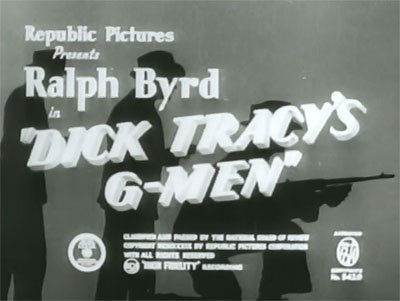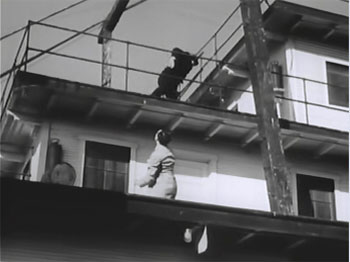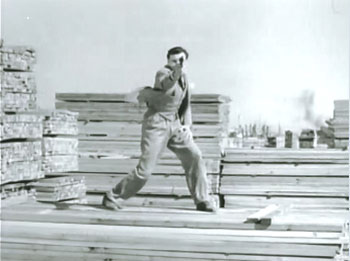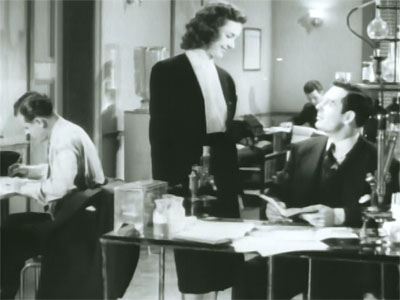
Republic, 15 Chapters, 1939. Starring Ralph Byrd, Irving Pichel, Ted Pearson, Phyllis Isley, Walter Miller, George Douglas, Kenneth Harlan.
Dick Tracy’s G-Men begins with a newsreel recounting the capture of international spy-for-hire Nicholas Zarnoff (Irving Pichel), by a squad of FBI agents led by Dick Tracy (Ralph Byrd); the end of the newsreel features Tracy announcing the date of Zarnoff’s pending execution. Zarnoff apparently goes to the gas chamber on schedule, after assuring his nemesis Tracy that this is only the first round. This statement proves to be more than a boast when Zarnoff’s “body” is hijacked by his henchmen Robal (Walter Miller) and Sandoval (George Douglas). We soon learn that Zarnoff, just before the execution, swallowed a drug which placed him in suspended animation, thus preventing any gas from entering his lungs while making himself appear to be dead. The promised second round begins, with Tracy combating Zarnoff’s sabotage and espionage activities as he attempts to bring the master spy to a second and more conclusive defeat.
Dick Tracy’ s G-Men has always received less notice from fans than Republic’s other three Tracy serials; Dick Tracy has always been guaranteed attention (much of it negative) by its position as the first in the series, while Dick Tracy Returns and Dick Tracy vs. Crime Inc. have enjoyed continuing popularity because of the presence of Charles Middleton in the former and the use of an invisible mystery villain (the Ghost) in the latter. Dick Tracy’s G-Men, lacking an iconic villain or a science-fiction gimmick, tends to be complimented briefly and then ignored in most commentaries. This is unfortunate, since G-Men is an excellent serial, whether measured against its fellow Tracy outings or Republic’s other cliffhangers.
Dick Tracy’s G-Men’s basic plotline, in which Tracy duels with a formidable heavy and thwarts a succession of unrelated villainous schemes, is not all that different from the storylines of its predecessors; however, G-Men still has a smoother, more streamlined feel to it than either Dick Tracy or Dick Tracy Returns. The first two Tracy serials generally wrapped up each chapter’s criminal sub-plot right after the cliffhanger resolution, then sent Tracy back to his headquarters, where he would analyze clues leading to the discovery of the villains’ next enterprise. G-Men has far fewer stop-and-start points and fewer adjournments to the crime lab; its narrative frequently moves Tracy and his G-Men directly from raid to raid without any trips to HQ.
This pulling-out of stops not only quickens the pace but also makes Tracy’s duel with Zarnoff seem more urgent than his bouts with the previous serials’ heavies; the recapture of the master spy remains Tracy’s overriding objective throughout, and the defeats of Zarnoff’s incidental schemes come off as side effects of Tracy’s ongoing pursuit, diminishing the chapterplay’s episodic feel. The serial’s writers, Barry Shipman, Rex Taylor, Sol Shor, Ronald Davidson, and Franklin Adreon, deserve credit for finding ways to improve on an already-effective formula without altering its fundamental strengths; they also should be credited for removing the unnecessary Mike McGurk and Junior characters from this outing, another decision that helps to streamline Dick Tracy’s G-Men.
In common with its two predecessors, Dick Tracy’s G-Men features an incredible array of action sequences, filmed in and around an interesting variety of “real-world” locations. There’s a very long fight/shootout/chase between the G-men and Zarnoff’s lieutenants at a dockyard, with Tracy pursuing the bad guys across docks and along the upper deck of a ship. There’s a lengthy sequence at a dam, with Tracy going underwater via the dam’s peculiar elevator to raid a diving-bell hideout; this sequence culminates with an excellent cliffhanger that has Tracy, his air cut off, trapped underwater on the stalled elevator.


Above: Scenes from the dockyard chase.
Yet another action highlight has Tracy swooping down in a biplane to board an explosive-laden, remote-controlled motorboat–an expert combination of outdoor stuntwork and process-screen shots. Then there’s a long and elaborately staged fight at a lumber yard, which features a dramatically-filmed sequence that has Tracy standing atop a log pile and shooting at a villain-operated construction crane that slowly moves in on him; the moving-camera shots in this sequence make it one of the most memorably staged bits in any Republic serial. In addition to the on-location sequences, there’s a good shootout between Tracy’s men and Zarnoff’s thugs on Republic’s backlot Western street, which makes an unexpected but welcome appearance as a desert ghost town here.


Above: Tracy vs. the crane and its driver.
The fights in Dick Tracy’s G-Men are much more acrobatic and more carefully staged than similar sequences in the earlier Tracy serials; by 1939 directors William Witney and John English were well on their way towards perfecting serial fight scenes. Some of the highlights include the fight between Tracy (doubled by George DeNormand) and two of Zarnoff’s men in an alley in the first chapter, a fight between Tracy, Steve Lockwood, and a set of villains at a lighthouse (a sequence that makes good use of the lighthouse’s circular staircase), and the above-mentioned dockyard and lumber yard fights. Assisting or opposing DeNormand in the various battles are (among others) Tom Steele, Ken Terrell, Ted Mapes, Carey Loftin, Allen Pomeroy, Bud Wolfe, and Eddie Parker. Mapes and Terrell also appear in acting capacities throughout the serial–Mapes as one of Tracy’s trusty squad of G-men and Terrell as one of Zarnoff’s henchmen; the other stuntmen put in occasional acting appearances as well. For once in Republic’s Golden Age, David Sharpe seems absent from a serial’s stunt team–possibly because he was playing a co-starring role in Daredevils of the Red Circle, which was filmed around the same time.
The serial’s cliffhangers are as varied and as memorable as its locations and action scenes. Besides the diving-elevator scene already referred to, there’s the Chapter Two cliffhanger in which Zarnoff elaborately arranges for Tracy to be shot by his own men, the Chapter Eleven cliffhanger with Tracy and Lockwood trapped in an underground mine explosion, and the Chapter Twelve cliffhanger, with Tracy fighting a human-fly henchman of Zarnoff’s while dangling from the undercarriage of an autogyro and then taking an apparently fatal plunge. This scene, like many others in the serial, features some great miniature work by Howard and Theodore Lydecker.
Dick Tracy’s G-Men includes fewer supporting characters–heroic or villainous–than either Dick Tracy or Dick Tracy Returns; the serial focuses almost continually on Tracy and Steve Lockwood on one side and Zarnoff and his henchmen Robal and Sandoval on the other. Boiling down the cast to essentials works better here than in many of Republic’s 1950s serials, mainly because both this serial’s hero and villain are more interesting than others of their kind. Ralph Byrd’s acting in G-Men is more relaxed and less intensely dramatic than in his earlier Tracy outings or in SOS Coast Guard, but no less appealing. He once again succeeds in making Tracy seem human despite the character’s superhuman tendencies–conveying frustration, apprehension, and determination in equal measure during chases, fights, or moments of peril. He’s also allowed a few more wryly humorous moments than in previous cliffhangers; his cheerful delivery of the line “I never did like poisonous gas” is particularly funny–sounding almost like an in-joke when one recalls Tracy’s bouts with noxious fumes in his previous serial adventures.
Irving Pichel, though lacking the grotesqueness of the Lame One and the violent edge of Pa Stark, is a strong and memorable opponent for Byrd. Always relaxed to the point of laziness, yet shrewd and alert (as when he casually leans on his elbow while questioning Tracy in Chapter One), he’s highly reminiscent of a sleek but intelligent cat. Pichel’s rich, smooth, and self-assured voice complements his feline manner perfectly; the striking contrast between his ruthless actions and his urbane demeanor serves to make his villain as memorable as any more bad-tempered or aggressive heavy. He’s particularly impressive when depicting Zarnoff’s reactions to the suspended-animation drug, and in the scene where Zarnoff recovers from its effects–quietly swearing vengeance on Tracy for “driving” him to the use of the devastating potion.

Above: Zarnoff watches coolly as the agents of the “Three Powers” look over his contract for espionage services.
Ted Pearson doesn’t give Steve Lockwood as much personality as Fred Hamilton did in Dick Tracy, but he’s more distinctive than the bland Michael Kent in Dick Tracy Returns, playing the character in a down-to-earth and slightly hard-boiled manner. Jennifer Jones, billed under her real name (Phyllis Isley), takes over the role of Gwen Andrews, which is reduced even more than Lynne Roberts’ turn as Gwen was in Dick Tracy Returns. It’s ironic that probably the best and certainly the best-known actress to appear in a Republic serial has one of the smallest roles of any of the studio’s chapterplay leading ladies; one can picture Republic bosses, after Isley became Oscar-winner Jennifer Jones, wishing that they had given her something to do in G-Men beyond answering Tracy’s phone, making radio calls for him, and filing papers.

Above: Tracy urges Gwen to rest up after an all-night code-breaking session, in the most noticeable bit Jennifer Jones receives in the entire serial.
Walter Miller, a splendid lead villain in many Universal serials, is reduced to an henchman role here, but still gets a lot of mileage out of his part as Zarnoff’s lieutenant Robal. He receives about as much screen time as Pichel himself, while taking part in much more active villainy than his boss. Miller plays his role with the same intensity and aggressiveness he brought to his Universal roles, managing to avoid being overshadowed by either Byrd or Pichel. George Douglas, who played many slick brains heavies in Republic’s B-westerns features, is good as Zarnoff’s other lieutenant, the smooth Sandoval, but doesn’t get in on nearly as much action as Miller does.
Dick Tracy’s G-Men, in the tradition of most 1930s Republic serials, features a stellar cast of character players in supporting roles. Former silent star Kenneth Harlan appears as Tracy’s FBI superior Clive Anderson towards the end of the serial, playing the role with much more energy than Francis X. Bushman and James Blaine did and getting more to do than either of them–taking part in a fight at Zarnoff’s headquarters, holding villains at gunpoint, and barking orders to both Lockwood and Tracy. Budd Buster has a funny guest appearance as a feisty old lighthouse keeper, and Stanley Price plays a good guy for once—a chemist who identifies the drug Zarnoff uses to cheat death in the first chapter. Peppery George Cleveland, a distinguished character actor in features, TV, and serials alike, puts in an appearance as a rheumatic gas-station proprietor who helps Tracy during the G-men’s search for Zarnoff’s ghost town hideout, while Sammy McKim has a good part as Cleveland’s young grandson–who saves Tracy and Lockwood’s life in the ensuing ghost-town ruckus.
William Stahl, Julian Madison, Robert Wayne, and Robert Carson (a prolific TV character actor in later years), along with the aforementioned Ted Mapes, are all members of Tracy’s G-man squad, while Joe McGuinn, Jack Ingram, Ethan Laidlaw and Bud Geary play various Zarnoff henchmen. Forrest Taylor pops up as an aircraft designer, Edward Hearn as a forest ranger, Ed Cassidy as a ship’s captain, Josef Swickard as a South American president whom Zarnoff tries to assassinate, and Edmund Cobb as one of the US soldiers supervising the “Great Industrial Canal.” Tristram Coffin can be briefly spotted as one of the “Three Powers” representatives that contract with Zarnoff, and Harrison Greene has a more extended role as another foreign agent doing business with the Zarnoff organization (he played practically identical roles in both Dick Tracy and Dick Tracy Returns).
Dick Tracy’s G-Men may lack a hook to immediately snag the interest of serial buffs, but its location shooting, action scenes and lead performances all place it right alongside its better-known contemporaries. Always highly-rated, yet perennially overlooked, it deserves more attention from fans of Republic’s Golden Age cliffhangers.

I found this the best of the Dick Tracy serials, with spectacular action, and a great villain. I have only seen Irving Pichel in this one and Dracula’s Daughter, but in both he is outstanding. I would consider his Zarnoff an “iconic” villain. Ralph Byrd is really at the top of his game in this one, and the cliffhangers are outstanding, especially the zeppelin sabotage bit, an all-time favorite for me. ***** out of *****
Interesting trivia note:
It was from the newsreel framing device in the first chapter of this serial that Orson Welles got the notion of using a similar framing device in CITIZEN KANE. In a 1971 interview, Welles said, “I loved the Tracy chapter-plays, and the ‘true-crime’ newsreel sequence in that one serial was enough to make me feel as though the story was unfolding in life. The actual Hollywood-studio newsreels, after all, were what kept a matinée at the Bijou anchored in a real-world sensibility. And how better to acquaint the audience with ol’ Charlie Kane, than with a convincing newsreel segment.”
I always found this the very best of the four TRACY serials, and, in tone at least, the closest to the strip, with DICK TRACY RETURNS running a very close second.
I’m in total agreement with the previous posters about this one. It’s my favorite of the four “Tracy” chapter plays that were produced, with a great, fast-moving storyline and a terrific performance by Pichel as the lead villain. Acting, location work, and stunts are all top-notch as well. As you mentioned, the characters of McGurk and Junior were unnecessary and their omission wasn’t missed at all. The ending is sometimes criticized as being too “flat” and unspectacular, but to me it seemed to be a very dramatic and fitting end for Zarnoff.
I actually remember the old La Reina Theatre that was featured in the newsreel opening. It was in Sherman Oaks on Ventura Blvd, and was pretty nice in its day.